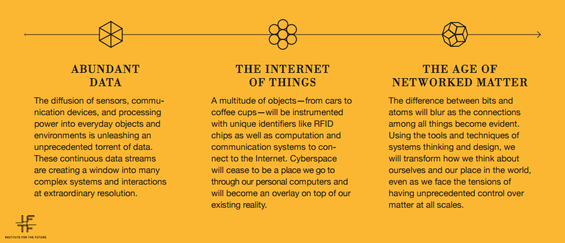Future Now
The IFTF Blog
Programming the Global Food System in the Age of Networked Matter
![]() This post originally appeared in Food+Tech Connect's Internet of Food series.
This post originally appeared in Food+Tech Connect's Internet of Food series.
“The world is full of magic things, patiently waiting for our senses to grow sharper,” wrote poet W. B. Yeats.
Until now, we have been mostly blind to the systems and networks of systems that underpin our physicality. But over the next decade, a confluence of breakthroughs in physics, engineering, biology, computation and complexity science will give us new lenses to observe the wondrous interconnections surrounding us and within us. It is in those systems—from the microbial to the planetary—where the potential truly lies to improve our lives, restore our planet and understand our universe.
So begins Institute for the Future’s (IFTF) 2013 map, Age of Networked Matter, a journey through three time horizons to a future of immense possibility. Beyond the current flood of Abundant Data, and just past the promise of the Internet of Things, we find a world where everything is interconnected in entirely new ways. It is the Age of Networked Matter.

When thinking about the future of food in this world, we must think about how to develop and harness our technological capabilities for resiliency, equity and stability. The interactions of food with soil, shipping crates, packaging, processing and cooking and our bodies are inherently complex. An influx of data-driven food production, distribution, and 3D printing efforts create a window into these interactions at extraordinary resolution. The Internet of Food—emerging as fields of sensors, connected cups and handheld scanning devices—is beginning to add a virtual overlay to this reality, reshaping the ways in which we engage with this data in daily food experiences.
Imagine what will happen when the connections within the entire global food system are not only evident, but also programmed—when natural and artificial objects can communicate and work in concert with each other. To picture this world, I highlight one forecast at each scale listed in the Age of Network Matter map and its possible food system impacts [see all forecasts across these four scales in the map]:
Micro scale | adaptive atoms: toward programmable materials
Breakthroughs in nanoengineering, info-chemistry and materials science will deliver machines and materials that can adapt and self-organize in changing contexts, such as projects from MIT’s Self-Assembly Lab. This might manifest as seeds that are programmed to adapt to sudden shifts in weather conditions, or logistics systems that automatically reroute spoiled food to a compost facility based on microbial change.
People scale | organizations as algorithms: toward computable work
In traditional computing, the human provides the framework and algorithm, and computing power provides the answer. Emerging systems flip this relationship, designed to route problems to the right people at the right time, such as tools currently used for efficient warehouse operations. In the Age of Networked Matter, a single restaurant software program might place and track supply orders, coordinate staff schedules, manage finance and customer feedback, and even synthesize all this information to refine menus according to eater taste, ingredient availability, and food prices.
City scale | social robots: toward robot co-dependence
As robots become pervasive mobile nodes on the network, they will become socially engaged with each other. Like ant colonies, groups of robots will work together on a multitude of tasks, even to form a robot orchestra. Though already prevalent on farms, these more collaborative robots might become integral for food distribution in dense urban areas or essential for food security during natural disasters.
Planetary scale | interplanetary internet: toward a networked space age
As entrepreneurial ventures for medicine, manufacturing, and even tourism drive the space race, new technology will be deployed to network space vehicles, satellites, and eventually human habitats (and farms needed to feed them). These programs will likely accelerate new technologies on Earth, particularly as we are faced with growing food in rapidly changing climates.
This networked future might seem daunting, but it is one that we need to consider as we innovate today—especially with the long-term and far-reaching impacts of food system efforts. Abundant Data and the Internet of Food are the scaffold for this coming Age of Networked Matter. What are you building?
IFTF’s Food Futures Lab identifies and catalyzes the innovations that have the potential to reinvent our global food system. We seek to understand the motivations, drivers, and impacts of food innovation, and to align the minds and resources shaping the future of food. We impart a shared understanding of how to take the long-term view—one that encompasses multiple scales, uncertainties, and radically different possibilities for the future of food. We develop foresight and insight that help all eaters take action toward a more resilient, equitable, and delicious future of food.
Curious about the Food Futures Lab?
- Follow the program at @iftf
- Find out more about the program
- Check out previous years' research
- Contact Dawn Alva for more about our research ([email protected]) and Rebecca Chesney ([email protected] )for more about our special projects and events



